ECU YAMAHA VIKING 2014 Owners Manual
[x] Cancel search | Manufacturer: YAMAHA, Model Year: 2014, Model line: VIKING, Model: YAMAHA VIKING 2014Pages: 180, PDF Size: 3.78 MB
Page 16 of 180
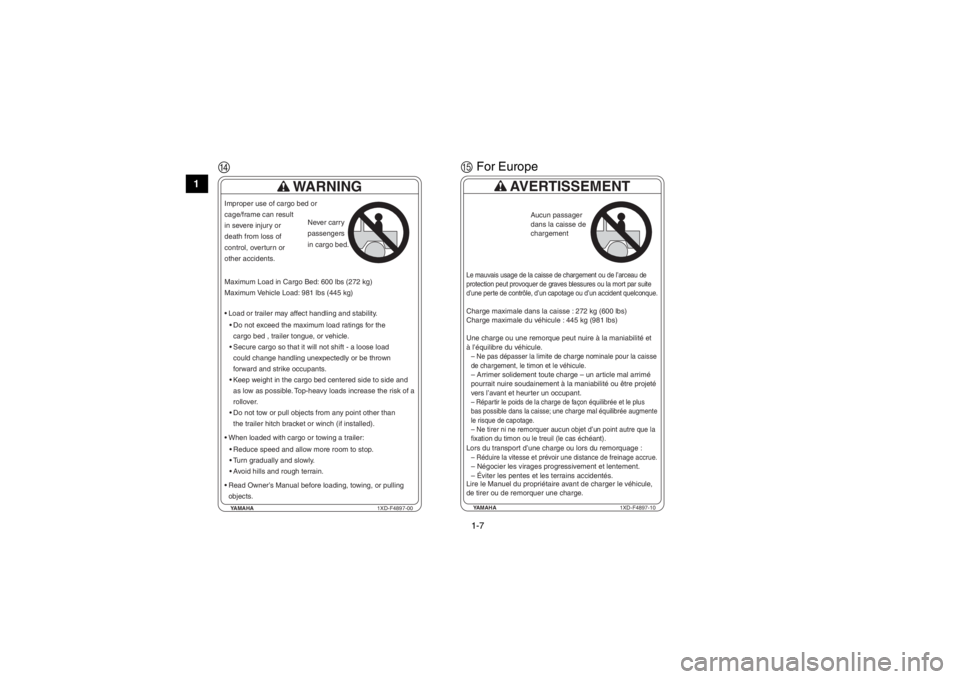
1-7
1
2
3
4
5
6
7
8
9
10
11
12
13
14
D
YAMAHA 1XD-F4897-00
WARNING
Load or trailer may affect handling and stability.
Do not exceed the maximum load ratings for thecargo bed , trailer tongue, or vehicle.
When loaded with cargo or towing a trailer: Reduce speed and allow more room to stop.
Turn gradually and slowly.
Avoid hills and rough terrain. Secure cargo so that it will not shift - a loose loadcould change handling unexpectedly or be thrown
forward and strike occupants.
Keep weight in the cargo bed centered side to side and as low as possible. Top-heavy loads increase the risk of a
rollover.
Do not tow or pull objects from any point other than the trailer hitch bracket or winch (if installed).
Read Owner’s Manual before loading, towing, or pulling objects.
Improper use of cargo bed or
cage/frame can result
in severe injury or
death from loss of
control, overturn or
other accidents.
Maximum Load in Cargo Bed: 600 lbs (272 kg)
Maximum Vehicle Load: 981 lbs (445 kg)
Never carry
passengers
in cargo bed.
E
For Europe
YAMAHA 1XD-F4897-10
AVERTISSEMENT
Charge maximale dans la caisse : 272 kg (600 lbs)
Charge maximale du véhicule : 445 kg (981 lbs)
Une charge ou une remorque peut nuire à la maniabilité et
à l’équilibre du véhicule.
Lors du transport d’une charge ou lors du remorquage :
Lire le Manuel du propriétaire avant de charger le véhicule,
de tirer ou de remorquer une charge.– Ne pas dépasser la limite de charge nominale pour la caisse
de chargement, le timon et le véhicule.– Réduire la vitesse et prévoir une distance de freinage accrue.– Négocier les virages progressivement et lentement.
– Éviter les pentes et les terrains accidentés.– Arrimer solidement toute charge – un article mal arrimé
pourrait nuire soudainement à la maniabilité ou être projeté
vers l’avant et heurter un occupant.– Répartir le poids de la charge de façon équilibrée et le plus
bas possible dans la caisse; une charge mal équilibrée augmente
le risque de capotage.– Ne tirer ni ne remorquer aucun objet d’un point autre que la
fixation du timon ou le treuil (le cas échéant).Le mauvais usage de la caisse de chargement ou de l’arceau de
protection peut provoquer de graves blessures ou la mort par suite
d’une perte de contrôle, d’un capotage ou d’un accident quelconque.
Aucun passager
dans la caisse de
chargement
1XP7B_EE.book Page 7 Tuesday, February 4, 2014 3:40 PM
Page 17 of 180
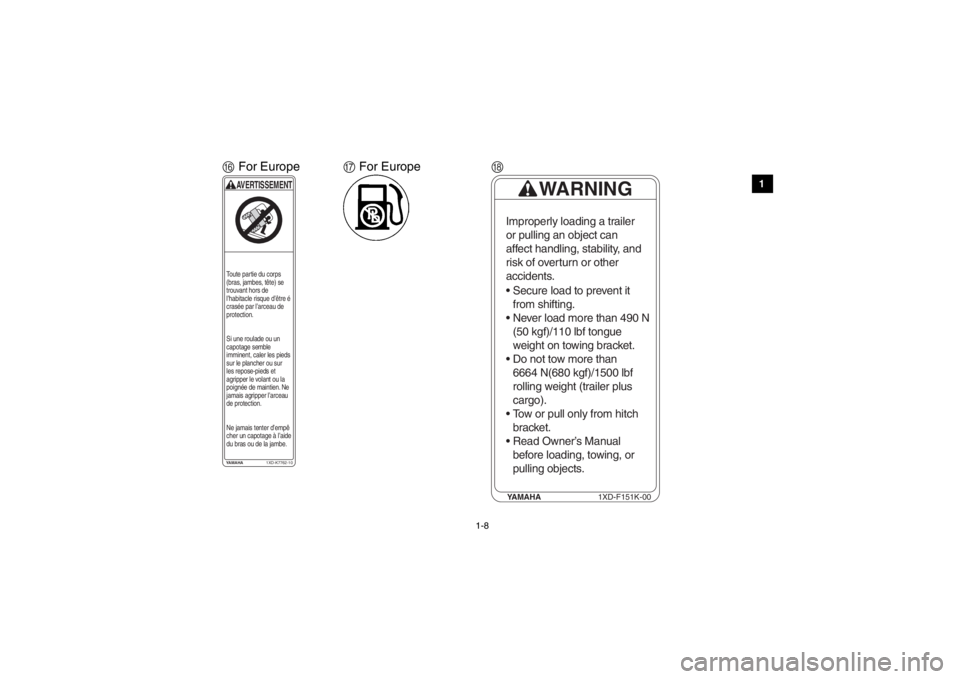
1-8
1
2
3
4
5
6
7
8
9
10
11
12
13
14
FFor EuropeYAMAHA 1XD-K7762-10AVERTISSEMENTToute partie du corps
(bras, jambes, tête) se
trouvant hors de
l’habitacle risque d’être é
crasée par l’arceau de
protection.
Si une roulade ou un
capotage semble
imminent, caler les pieds
sur le plancher ou sur
les repose-pieds et
agripper le volant ou la
poignée de maintien. Ne
jamais agripper l’arceau
de protection.
Ne jamais tenter d’empê
cher un capotage à l’aide
du bras ou de la jambe.
GFor Europe
H
YAMAHA
1XD-F151K-00
WARNING
Improperly loading a trailer
or pulling an object can
affect handling, stability, and
risk of overturn or other
accidents.
Secure load to prevent it
from shifting.
Never load more than 490 N (50 kgf)/110 lbf tongue
weight on towing bracket.
Do not tow more than 6664 N(680 kgf)/1500 lbf
rolling weight (trailer plus
cargo).
Tow or pull only from hitch bracket.
Read Owner’s Manual before loading, towing, or
pulling objects.
1XP7B_EE.book Page 8 Tuesday, February 4, 2014 3:40 PM
Page 19 of 180
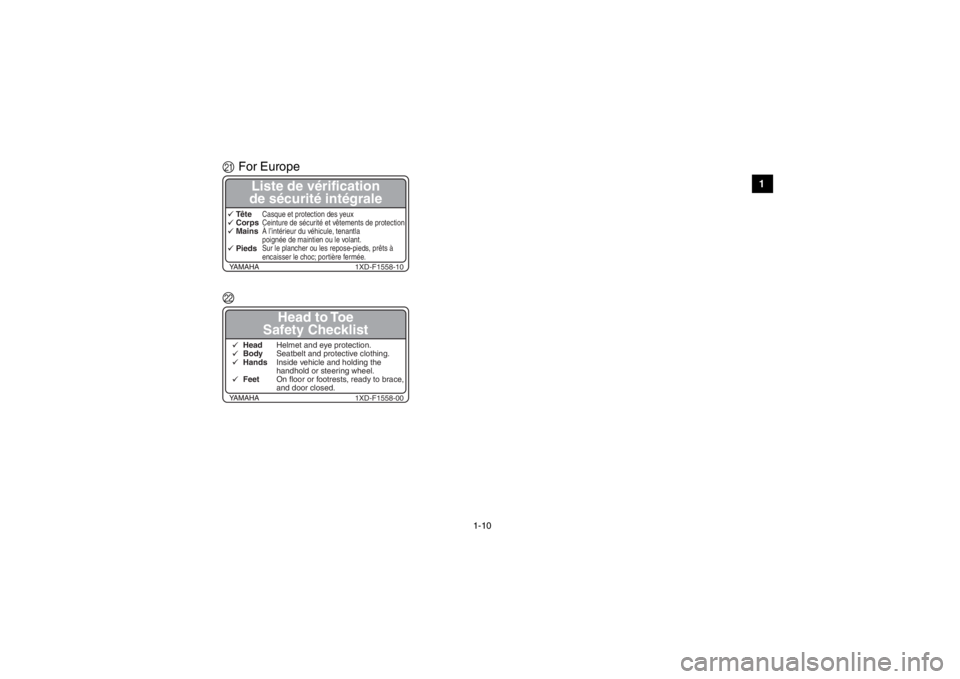
1-10
1
2
3
4
5
6
7
8
9
10
11
12
13
14
KFor Europe
L
1XD-F1558-10
Liste de vérification
de sécurité intégrale
Tête
Corps
Mains
Pieds
Casque et protection des yeux
Ceinture de sécurité et vêtements de protection
À l’intérieur du véhicule, tenantla
poignée de maintien ou le volant.
Sur le plancher ou les repose-pieds, prêts à
encaisser le choc; portière fermée.
1XD-F1558-00
Head to Toe
Safety Checklist
Head
Body
Hands
Feet
Helmet and eye protection.
Seatbelt and protective clothing.
Inside vehicle and holding the
handhold or steering wheel.
On floor or footrests, ready to brace,
and door closed.
1XP7B_EE.book Page 10 Tuesday, February 4, 2014 3:40 PM
Page 20 of 180
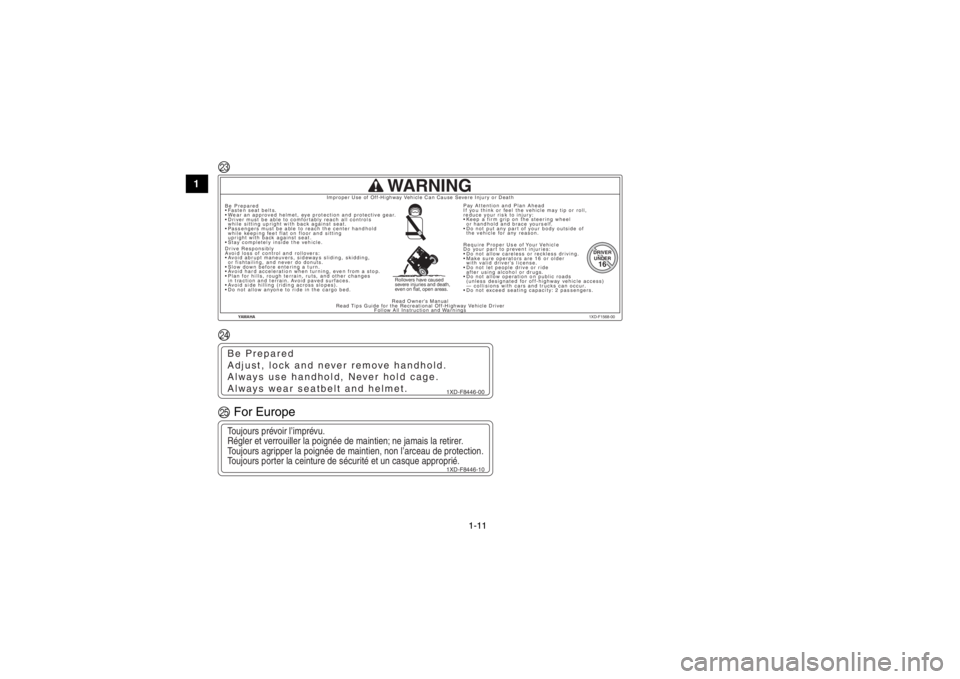
1-11
1
2
3
4
5
6
7
8
9
10
11
12
13
14
M
N
O For Europe
YAMAHA 1XD-F1568-00
WARNING
DRIVER DRIVER
UNDER
UNDER16
16DRIVERUNDER16
Improper Use of Off-Highway Vehicle Can Cause Severe Injury or Death
Read Owner’s Manual
Read Tips Guide for the Recreational Off-Highway Vehicle Driver Follow All Instruction and Warnings
Be Prepared
Drive Responsibly
If you think or feel the vehicle may tip or roll,
reduce your risk to injury: Pay Attention and Plan Ahead
Do not allow careless or reckless driving.
Do your part to prevent injuries: Require Proper Use of Your Vehicle
Rollovers have caused
severe injuries and death,
even on flat, open areas.
Stay completely inside the vehicle.
Passengers must be able to reach the center handhold
while keeping feet flat on floor and sitting
upright with back against seat.
Driver must be able to comfortably reach all controls
while sitting upright with back against seat.
Wear an approved helmet, eye protection and protective gear.
Fasten seat belts.
Do not allow anyone to ride in the cargo bed.
Avoid side hilling (riding across slopes).
Plan for hills, rough terrain, ruts, and other changes
in traction and terrain. Avoid paved surfaces.
Avoid hard acceleration when turning, even from a stop.
Slow down before entering a turn.
Avoid abrupt maneuvers, sideways sliding, skidding,
or fishtailing, and never do donuts.
Avoid loss of control and rollovers: Do not put any part of your body outside of
the vehicle for any reason.
Keep a firm grip on the steering wheel
or handhold and brace yourself.
Do not exceed seating capacity: 2 passengers.
Do not allow operation on public roads
(unless designated for off-highway vehicle access)
— collisions with cars and trucks can occur.
Do not let people drive or ride
after using alcohol or drugs.
Make sure operators are 16 or older
with valid driver’s license.
1XD-F8446-00
Be Prepared
Adjust, lock and never remove handhold.
Always use handhold, Never hold cage.
Always wear seatbelt and helmet.
1XD-F8446-10
Toujours prévoir l’imprévu.
Régler et verrouiller la poignée de maintien; ne jamais la retirer.
Toujours agripper la poignée de maintien, non l’arceau de protection.
Toujours porter la ceinture de sécurité et un casque approprié.
1XP7B_EE.book Page 11 Tuesday, February 4, 2014 3:40 PM
Page 21 of 180
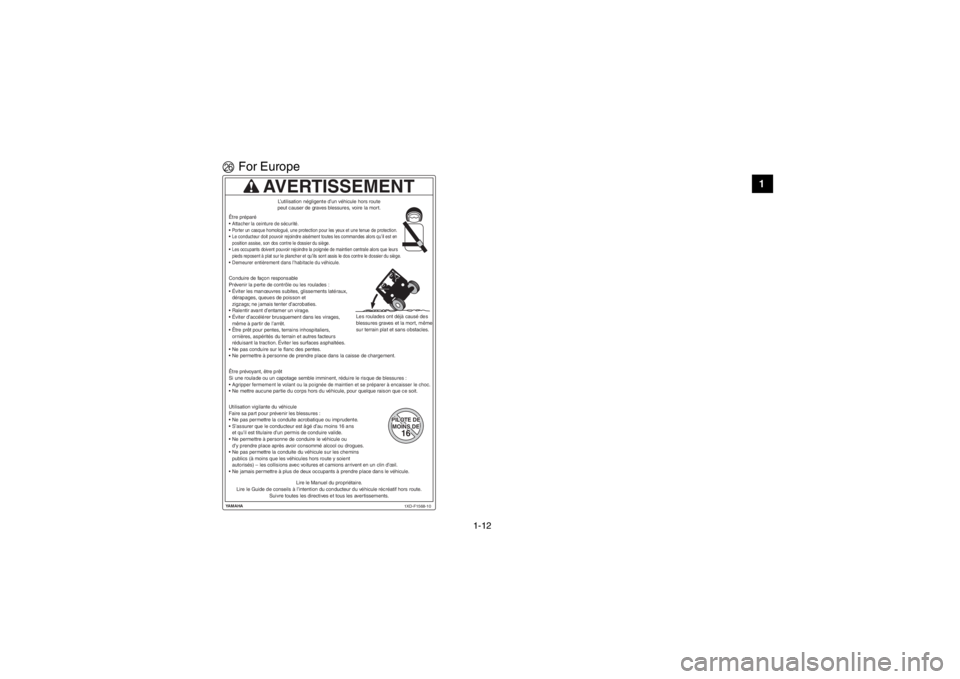
1-12
1
2
3
4
5
6
7
8
9
10
11
12
13
14
PFor EuropeYAMAHA
1XD-F1568-10
AVERTISSEMENT
PILOTE DEPILOTE DEMOINS DEMOINS DE1616PILOTE DE
MOINS DE16
Lire le Manuel du propriétaire.
Lire le Guide de conseils à l’intention du conducteur du véhicule récréatif hors route. Suivre toutes les directives et tous les avertissements.L’utilisation négligente d’un véhicule hors route
peut causer de graves blessures, voire la mort.
Les roulades ont déjà causé des
blessures graves et la mort, même
sur terrain plat et sans obstacles.
Utilisation vigilante du véhicule
Faire sa part pour prévenir les blessures : Ne pas permettre la conduite acrobatique ou imprudente.
S’assurer que le conducteur est âgé d’au moins 16 ans
et qu’il est titulaire d’un permis de conduire valide.
Ne permettre à personne de conduire le véhicule ou
d’y prendre place après avoir consommé alcool ou drogues.
Ne pas permettre la conduite du véhicule sur les chemins
publics (à moins que les véhicules hors route y soient
autorisés) – les collisions avec voitures et camions arrivent en un clin d’œil.
Ne jamais permettre à plus de deux occupants à prendre place dans le véhicule.
Être préparé
Attacher la ceinture de sécurité.Porter un casque homologué, une protection pour les yeux et une tenue de protection.Le conducteur doit pouvoir rejoindre aisément toutes les commandes alors qu’il est en
position assise, son dos contre le dossier du siège.Les occupants doivent pouvoir rejoindre la poignée de maintien centrale alors que leurs
pieds reposent à plat sur le plancher et qu’ils sont assis le dos \
contre le dossier du siège.Demeurer entièrement dans l’habitacle du véhicule.
Conduire de façon responsable
Prévenir la perte de contrôle ou les roulades :
Éviter les manœuvres subites, glissements latéraux,
dérapages, queues de poisson et
zigzags; ne jamais tenter d’acrobaties.
Ralentir avant d’entamer un virage.
Éviter d’accélérer brusquement dans les virages,
même à partir de l’arrêt.
Être prêt pour pentes, terrains inhospitaliers,
ornières, aspérités du terrain et autres facteurs
réduisant la traction. Éviter les surfaces asphaltées.
Ne pas conduire sur le flanc des pentes.
Ne permettre à personne de prendre place dans la caisse de chargement.
Être prévoyant, être prêt
Si une roulade ou un capotage semble imminent, réduire le risque de blessures :Agripper fermement le volant ou la poignée de maintien et se préparer à encaisser le c\
hoc.
Ne mettre aucune partie du corps hors du véhicule, pour quelque raison que ce soit.
1XP7B_EE.book Page 12 Tuesday, February 4, 2014 3:40 PM
Page 24 of 180

2-3
2
3
4
5
6
7
8
9
10
11
12
13
14
Prepare your vehicle
Perform the pre-operation checks each time you use the vehicle to make sure it is in safe operat-
ing condition. Failure to inspect or maintain the vehicle properly increases the possibility of an ac-
cident or equipment damage. See page 5-1 for a list of pre-operation checks.
Prepare your load or trailer
Carrying loads, towing a trailer, or pulling objects can affect handling, stability, and cause the risk
of overturns or other accidents. Read Chapter 6 before loading, towing, or pulling objects.
Do not overload the vehicle or trailer. Refer to label in cargo bed for cargo bed load limit. Re- fer to label next to hitch for tongue weight and trailer load limits.
Keep weight in the cargo bed centered side to side, and as low and as far forward as pos-
sible.
Secure cargo so that it will not shift – a loose load could change handling unexpectedly or be thrown forward and strike occupants.1XP7B_EE.book Page 3 Tuesday, February 4, 2014 3:40 PM
Page 49 of 180
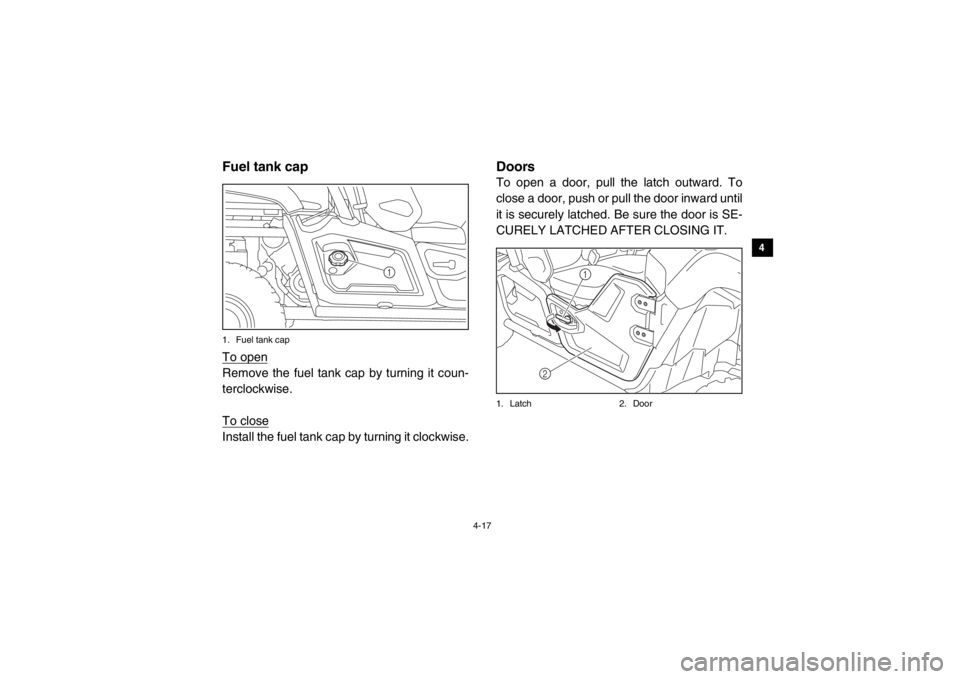
4-17
1
2
34
5
6
7
8
9
10
11
12
13
14
EVU00300Fuel tank cap1. Fuel tank capTo openRemove the fuel tank cap by turning it coun-
terclockwise.
To closeInstall the fuel tank cap by turning it clockwise.
DoorsTo open a door, pull the latch outward. To
close a door, push or pull the door inward until
it is securely latched. Be sure the door is SE-
CURELY LATCHED AFTER CLOSING IT.1. Latch2. Door
1
1
2
1XP7B_EE.book Page 17 Tuesday, February 4, 2014 3:40 PM
Page 50 of 180
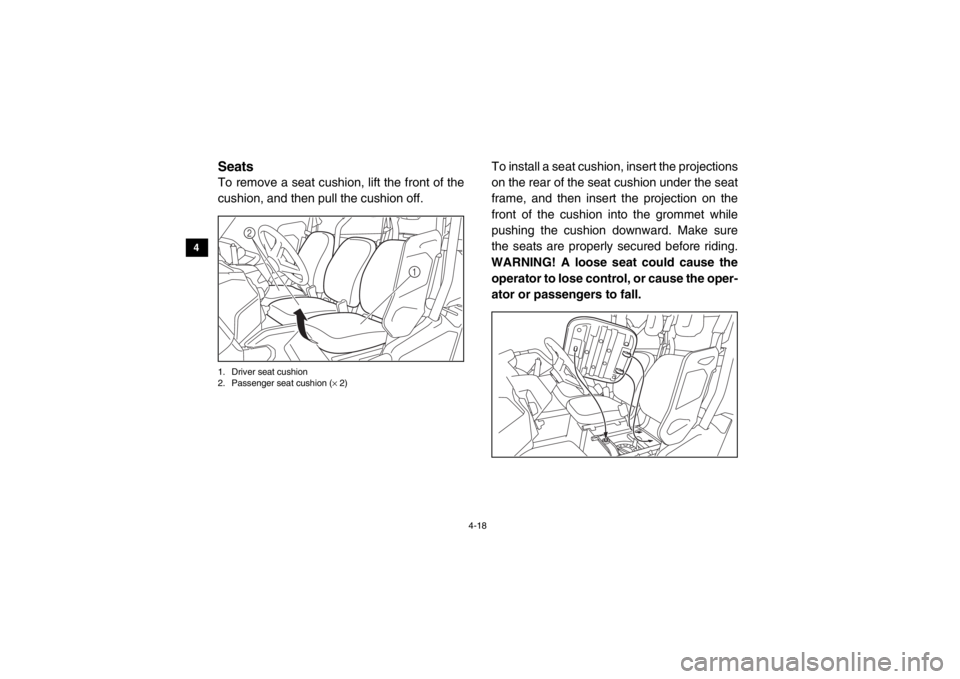
4-18
4
5
6
7
8
9
10
11
12
13
14
EVU00330SeatsTo remove a seat cushion, lift the front of the
cushion, and then pull the cushion off.1. Driver seat cushion
2. Passenger seat cushion ( × 2)
To install a seat cushion, insert the projections
on the rear of the seat cushion under the seat
frame, and then insert the projection on the
front of the cushion into the grommet while
pushing the cushion downward. Make sure
the seats are properly secured before riding.
WARNING! A loose seat could cause the operator to lose control, or cause the oper-
ator or passengers to fall.
1
2
1XP7B_EE.book Page 18 Tuesday, February 4, 2014 3:40 PM
Page 67 of 180

5-5
1
2
3
45
6
7
8
9
10
11
12
13
14
Portable fuel containers
If you carry a portable fuel container in the bed
of your Yamaha Viking, be sure to secure it
with the cap tightened before driving the vehi-
cle.
Always place a portable fuel container on the
ground before filling it. Before removing the
container cap, touch the container with the
fuel dispenser nozzle. Keep fuel dispenser
nozzle in contact with container inlet when fill-
ing. WARNING! Never refill a fuel container
in the bed of any vehicle. Fire may result
from a build-up of static electricity. The
discharge of this build-up while refueling
can cause a spark and ignite the gasoline.
Recommended fuel:
Regular unleaded gasoline only
For Europe:
Regular unleaded gasoline only with a re-
search octane number of 95 or higher
Fuel tank capacity: 36.7 L (9.70 US gal, 8.07 Imp.gal)
1XP7B_EE.book Page 5 Tuesday, February 4, 2014 3:40 PM
Page 69 of 180

5-7
1
2
3
45
6
7
8
9
10
11
12
13
14
EVU00430Final gear oilMake sure the final gear oil is at the specified
level. Add oil as necessary. (See page 8-15
for details.)
If desired, an SAE 80W-90 hypoid gear oil
may be used for all conditions.TIPGL-4 is a quality and additive rating; GL-5 or
GL-6 rated hypoid gear oils may also be used.EVU00440Differential gear oilMake sure the differential gear oil is at the
specified level. Add oil as necessary. (See
page 8-17 for details.)
EVU00450Accelerator pedalCheck to see that the accelerator pedal oper-
ates correctly. It must operate smoothly and
spring back to the idle position fully when re-
leased. Have a Yamaha dealer repair as nec-
essary for proper operation.EVU00460Seat beltsMake sure that the seat belts are not frayed,
torn, stretched, or damaged. The seat belts
must move smoothly when pulled out and re-
tract on its own when released. The seat belts
must also lock up when quickly pulled out.
The latch plate should click securely into the
buckle and release when the release button is
pushed firmly. Wash off any dirt or mud that
could affect operation. Have a Yamaha dealer
repair as necessary for proper operation.
Recommended oil:
SAE 80 API GL-4 Hypoid gear oil
Recommended oil: SAE 80 API GL-4 Hypoid gear oil
1XP7B_EE.book Page 7 Tuesday, February 4, 2014 3:40 PM